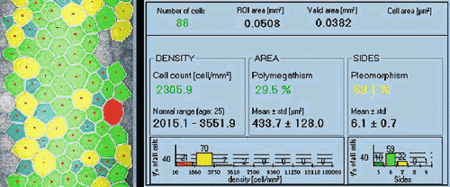Confocal microscopy becoming more useful
The once expensive technology has undergone major improvements, making it more feasible for clinicians to own.
KOLOA, Hawaii — Commercially available confocal microscopes are now demonstrating that the technology is not as expensive and cumbersome as it once was.
 
|
The ASL-1000 Confocal Microscope (Advanced Scanning Ltd.) and the ConfoScan2 (Nidek Technologies) are two confocal microscopes available now for anterior segment work.
Stephen D. Klyce, PhD, of the LSU Eye Center in New Orleans, said that clinical use of confocal microscopy will increase in the future as practitioners realize the machines are valuable and more easy to use. He described the current state of the technology here at Hawaii 2001, the Royal Hawaiian Eye Meeting, sponsored by Ocular Surgery News in conjunction with the New England Eye Center.
“This is a minimally invasive device,” Dr. Klyce said in discussing the benefits of the ConfoScan2. “A drop of ophthaine, couple the objective with gel to the corneal surface [and you get] 1,0003 magnification. There’s automatic alignment in scanning. You can accomplish pachymetry, automatic endothelial cell counts and you can integrate this into the Nidek NAVIS office system.”
Impractical past
Confocal microscopy was originally not embraced by the ophthalmic community, according to Dr. Klyce.
|
“About 15 years ago, a confocal microscope could be used to take pictures of the cornea and anterior segment,” he said. “It was a cumbersome set of optics connected to a room full of computer equipment and had to be attended by an ophthalmologist and at least two PhDs to get reasonable pictures. It also cost upwards of $1 million and certainly wasn’t practical to be used in an office such as yours.”
But with advances in the technology, these problems are less prevalent today.
“Over that decade and a half, a number of individuals have made major strides in trying to bring forth this technology and put it into a form and a format that you could not only afford but bring into your clinic and actually use in a practical way,” he said.
Two devices
A major difference between the two commercially available machines is that the ASL-1000 uses a scanning spot while the ConfoScan2 uses a scanning slit.
The ASL-1000 “contacts the cornea directly, which makes finding where you are in the Z plane easier,” Dr. Klyce said.
The scanning slit confocal microscope does not touch the cornea, but is coupled to the cornea with a gel that reduces specular reflection from the epithelial surface.
Dr. Klyce said the confocal slit scanning method reduces light scatter from adjacent tissue and allows quite good contrast in optics when viewing living tissues.
Improvements and use
|
“You can use this kind of information to determine thickness,” Dr. Klyce said. “For example, as well as measuring haze you can actually integrate the amount of light coming from the section and get an objective measurement of haze which can be useful in quantitating [diffuse lamellar keratitis] in the cornea after LASIK. You can use this to measure epithelial thickness, depth of the LASIK interface, locate structures in the cornea relative to surfaces and so on.”
In the past, these types of machines were difficult to use, Dr. Klyce noted. They had to be operated in manual mode by turning Vernier dials.
“One of the things that I tried to help with in the evolution of this device was to make it easy for everybody to use. To do that, I worked with the Nidek team to make an automatic mode,” Dr. Klyce said.
“Basically, the joystick would control the initiation of the sequence to help put the scene of the objective within the cornea, and then by pushing a button one could automatically find the endothelium and then realign the microscope to the apex of the cornea. That process makes it very simple for people to use this machine. It takes about 20 seconds, once you find the cornea, to do this.”
The device can also do automatic cell counting so the physician can compute the amount of polymegathism and pleomorphism automatically.
For Your Information:
- Stephen D. Klyce, PhD, can be reached at LSU Eye Center, Suite B, 2020 Gravier St., New Orleans, LA, 70112; (504) 412-1100 ext. 1329; fax: (504) 412-1315. Dr. Klyce is a paid consultant for Nidek technologies.
- For information on the Advanced Scanning Ltd. ASL-1000 tandem scanning microscope, contact Roger Beuerman at (504) 412-1331.
- Nidek Technologies, manufacturer of the ConfoScan2 confocal microscope, can be reached at 5500 West Friendly Ave., Greensboro, NC 27410; (336) 851-0225; fax: (336) 851-0917.


